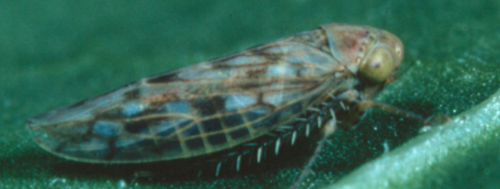Resilience and Adaptation: Collaborative Efforts Secure Tomato Supply in California
Tomato planting in California for the 2024 season is nearing completion. Despite mild interruptions due to weather, most tomato growers have managed to plant fairly close to schedule. It has been fortunate for California tomato growers to not have to worry about severe weather conditions this planting season because there are other areas that require their focus.

FIGURE 1 – Sugar Beet Leafhopper
A new rule banning the application of neonicotinoids on flowering plants went into effect this year, affecting processing tomatoes among other crops. Traditionally, a significant portion of tomato growers in the southern region of the state, who have experienced curly top damage from sugar beet leafhoppers in the past, or have heard about their neighbors experiencing damage, have used an insecticide in the greenhouse prior to transplanting to protect the young plants from leafhoppers. The leafhoppers are vectors for the curly top virus, which kills the plant (See Figure 1).
Kern County, one of the southernmost growing counties in California, proclaimed a local emergency in early April to protect their 8,000 to 10,000 acres of processing tomatoes by allowing the application of neonicotinoid pesticide if the leafhoppers in that area posed a serious threat. Northern counties with past leafhopper issues followed suit and have declared or are in the process of declaring emergencies, although the rains in the hills resulted in good annual grass growth, which helped to minimize the growth of leafhopper host plants.
News headlines announcing the emergency declaration and use of neonicotinoids caused concerns for some customers over potential supply reliability. However, the emergency declaration is a precautionary safety measure.

FIGURE 2: Branched Broomrape Weed
Another top priority for growers in California as we head into the summer months is the reemergence of the very evasive branched broomrape weed, a parasitic plant that attaches to the plant root below ground (See Figure 2) and can spread with exponential growth. In response to a severe infestation in the Sacramento Valley in the late 1950s, an industry-led effort funded through a marketing order program, which included fumigation, helped remedy the problem along with intensive surveys. With the weed’s reemergence, research has been ongoing both in California and other countries for treatment and eradication. Secretary of Agriculture Karen Ross has appointed a committee, and the first organizational meeting was held in mid-May. This committee is tasked with forming a strategic plan on how to cope with broomrape, minimize its growth, and/or eliminate this weed in California.
Morning Star is very active in the prevention and control of these invasive species. However, it should be noted that the issues discussed are currently isolated to particular regions. This is one of the many reasons Morning Star maintains a large, geographically diverse sourcing region. Should an incident occur in one growing region, we can still acquire raw products from the majority of other growing regions, which helps mitigate a catastrophic supply issue.
While growing tomatoes in California can’t be described as a profession without worries, the forethought and actions exhibited through the collaboration of growers and industry allies bring confidence that the tomato supply in California will be sufficient to meet the needs of its customers.

Damaged plant as a result of the curly top virus.

Branched broomrape weed in a tomato field.
###

Morning Star Newsletter now distributed electronically
As a reminder, Morning Star is now distributing our newsletters electronically using an email distribution vendor called Mailchimp. Your e-version will now include informative Morning Star videos and highlights. Depending on your company’s firewall, these emails may initially be directed to you spam folder.

